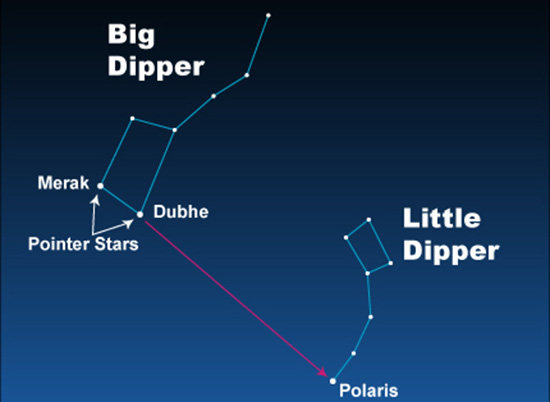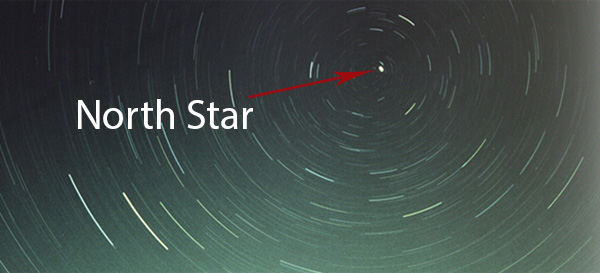Knowing how to find the North Star is one of the most basic survival skills.
This skill is important because the axis of Earth is pointed almost directly at it. During the course of the night, the North Star does not rise or set, but remains in very nearly the same spot above the northern horizon year-round while the other stars circle around it (actually the Earth’s spin gives us this perspective). If you were at the North Pole, the North Star would be directly over your head. The picture above is NOT edited in any way. it just has a long exposure (45 minutes)… so you can see the stars moving and in the middle: The North Star!
Because the North Star is known to stay fixed, always visible in a clear night sky (from the northern hemisphere) and always pointing north, our ancestors used it for thousands of years as a guiding star both on land and sea. Finding the North Star was one of the basic skills all navigators and travelers knew and used on a regular basis; a skill that has been forgotten by the masses since the invention of compass. But unlike the compass, the North Star always points to to TRUE NORTH. There is no magnetic declination to deal with.
Related: 24 Lost Survival Tips from 100 Years Ago
The North Star as we call it today is actually named POLARIS (by astronomers) and, surprisingly, it wasn’t always The North Star and it won’t always be:
“Thousands of years ago, when the pyramids were rising from the sands of ancient Egypt, the North Star was an inconspicuous star called Thuban in the constellation Draco the Dragon. Twelve thousand years from now, the blue-white star Vega in the constellation Lyra will be a much brighter North Star than our current Polaris. … So when you’re talking about stars “moving” or staying “fixed,” remember … they are all moving through the vastness of space. It’s just the relatively short time of a human lifespan that prevents us from seeing this grand motion.” (Source)
One of the easiest ways to find Polaris is by using the group of stars known as the Big Dipper or the Little Dipper.
So you can go outside tonight (or now if it’s already night) and try to find one of them first. The Big Dipper and the Little Dipper are actually the only groups of stars I know how to find. But I’ve known this since I was a little kid. It’s very easy.
If you find the Big Dipper first, locate the two stars Dubhe and Merak in the outer part of the Big Dipper’s bowl (see picture). Simply draw an imaginary line from Merak through Dubhe, and go about 5 times this distance to find Polaris.
If you find the Little Dipper first, Polaris is the last star in the handle of the Little Dipper.

After you find the star, stretch your arms sideways while facing it:
- In front of you is the True North
- Behind you is South
- Your right hand points due East
- Your left hand points due West
Another interesting fact about Polaris is that it isn’t just one star. What we call The North Star (or Polaris) is a system comprised of 3 stars: a super-giant and two smaller companions. But because of the huge distance and because the super-giant is one of the brightest stars in the night sky (50th) we see it as one star with the naked eye.
You may also like:
 How to Dry Plums for Long-Term Storage Just Like Grandma
How to Dry Plums for Long-Term Storage Just Like Grandma
US Nuclear Target Map. Do You Live in The Danger Zone? (Video)
Antibiotic Herbs And Plants To Grow Before SHTF
Can This Be A Better Alternative To Modern Antibiotics?
Image credits: Earth Sky











